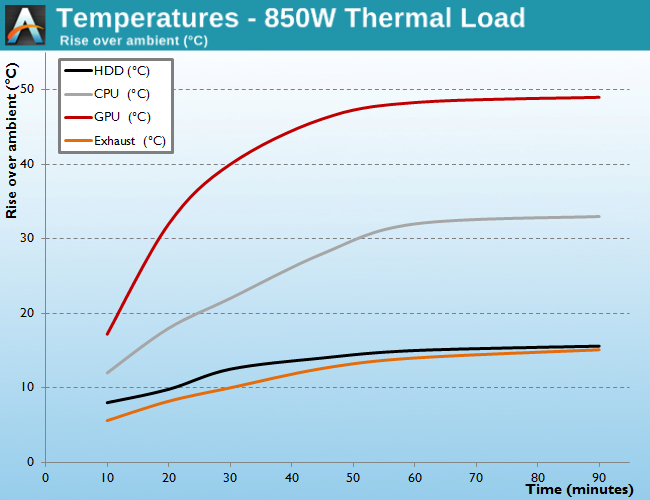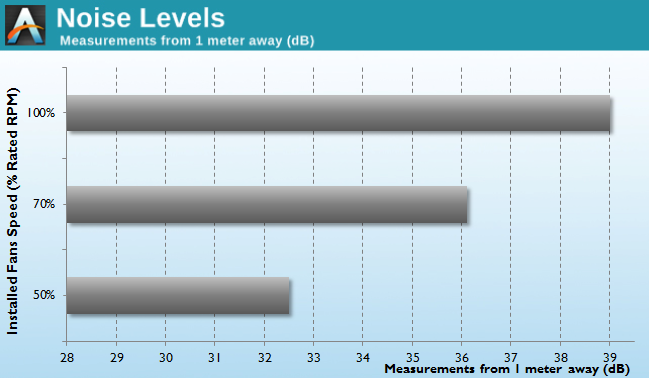Corsair Graphite 760T Case Review
by E. Fylladitakis on March 27, 2014 1:10 PM ESTTest Setup
Professional testing requires the emulation of real-world situations but with repeatable results; thus, a perfectly controllable test setup and environment are required, especially for comparable results. Testing the thermal performance of any case with a typical real-world setup technically limits the comparability of the results to this setup alone, as an active system interacts with its environment and the change of a single component alters (albeit in small ways) myriads of variables. In order to eliminate such factors, we developed synthetic loads that emulate the thermal output of real systems that are passive, steady and quantifiable.
Our thermal testing now displays the thermal capabilities of the case alone, as if it must deal with the entire thermal load by itself, regardless of the system that might be installed inside it. Laboratory data loggers are used to monitor the PT100 sensors and control the safety relays, which are fully accessible via our custom software. Three such loads have been developed, and today we'll be using the ATX load.
The ATX version simulates a 200W CPU, 50W VRM, 30W RAM and 4 × 120W GFX card thermal load; additionally, three 3.5" HDD dummy loads are also present that each convert 30W of electrical power to thermal, bringing the total thermal load of the ATX test setup up to 850W. As such, the thermal load is immense and only the best of cases will be able to handle it for more than a few minutes. We also test with a thermal load of 400W, with all of the aforementioned components except the HDD drives at about 42% power, which is more suitable for the majority of cases.
Thermal testing is performed with all of the case's stock fan operating at maximum speed. Noise testing is performed with a background noise level of 30.4dB(A).The top panel cover remained installed.
Results and Discussion
The thermal performance of the Corsair Graphite 760T is rather good but we cannot really claim that it is great considering the size and nature of the case. The stock cooling fans are not very powerful and ventilation depends on them while the top panel cover remains attached. It performed well enough to compete with mid-tower cases designed for maximum thermal performance, such as the Obsidian 450D, but the Graphite 760T is significantly larger and pricier.
The reduction of the load down to 400 Watts displays that the Graphite 760T has mediocre thermal inertia for a case this size. It appears that the thermal performance of the Graphite 760T heavily depends on the airflow of the cooling fans, at least while the top panel cover remains attached.
Probably due to the nature of the Graphite 760T, virtually no measures have been taken in order to reduce the noise coming from the case. Only the 3.5" devices are decoupled from the chassis; any vibrations from the PSU will be transferred directly to the chassis, as the unit sits on the metallic bottom of the case. The fascia not only is heavily perforated but it also has two 140mm fans directly exposed to the front of the case. The plastic cover of the top panel can block some of the noise but removing it exposes the entire top side of the case as well. As such, the Graphite 760T is definitely not a case specifically designed for silent computing. Nevertheless, the stock fans are not loud at all; they will be clearly audible only at their maximum speed and they reach virtually inaudible levels as soon as their voltage goes below 8V.













71 Comments
View All Comments
spidey81 - Thursday, March 27, 2014 - link
Wow! Such harsh words and negativity. First off, aesthetics is a very individual thing. Not everyone will like the look of the case. Secondly, I wish Corsair would take a stab at a case without 5.25 bays. NZXT did it and made a case that was absolutely stunning. Third, I don't mind the choice of plastic for the majority of the non-structural components. It however take away some of the rigidity of the case. I had hoped for a glass side panel honestly.Personally, I think the case looks fantastic and can't wait for other color schemes. I can see a lot of enthusiasts modding the front panel to remove the 5.25 altogether for a triple radiator or cleaner internals. Maybe adding risers to the top panel cover to achieve a clean look while allowing some airflow. It's not perfect, but it will have a good following I believe.
Cellar Door - Thursday, March 27, 2014 - link
Guys, I think it's time Anandtech got a new gallery. This new-window pop up is ancient, it does not support hover zoom. It is by far the least appealing feature of the site at the moment.zlandar - Thursday, March 27, 2014 - link
Reminds me of my 500R with similar dimensions. I don't see why this is worth $50 more retail than the 500R.Panzerknacker - Thursday, March 27, 2014 - link
Why don't they mention lack of sturdiness because I see videos on youtube of people bending the case as a whole.etamin - Thursday, March 27, 2014 - link
$189...Corsair is out of their mind. I'd be hard pressed to pay $100 for this garbage. From what I've been seeing on forums lately, Corsair's products have really dropped in quality and they're just milking their existing fanbase and riding the momentum fanboys are making. Outside their AX PSU's, Dominator RAM, and perhaps their dual rad AIO's, everything is run-of-the-mill crap nowadays.khanov - Thursday, March 27, 2014 - link
Wow it is so ugly you could mistake it for a new Thermaltake case.hp79 - Friday, March 28, 2014 - link
Looks nice and all, but I would never buy this case. Priced like as if it's made of special luxury material or something. I think I paid about $60 for my LianLi Q11, and thought it's a lot of money but spent it because cases usually last a very long time. I would think about it if the price was about $50 after rebate, but at this price, it's just lol.Ubercake - Friday, March 28, 2014 - link
I really like this case. The design is well thought out. Removable drive cages are great because most people don't need all of the slots. Removing unnecessary drive cages opens up airflow for the system. This is a huge deal since many cases still plop non-removable drive cages directly into the path of your intake fans with no option to remove them.This case accommodates large motherboards and three two slot GPU configurations easily. There's enough clearance between the top of the motherboard and the top of the case to easily fit a thick rad with push/pull fan configs. There's a lot of room for cable management. The 5.25" drive is going by the way of the dinosaur so 3x5.25 drive bays are more than enough for anyone not looking to create a burn station. I also like the full acrylic window displaying all of the system's components. This is pretty cool.
I haven't seen interior design this good on any models by any manufacturer with the exception of NZXT. Most NZXTs above the $100 mark incorporate a lot of these features plus SSD mounts on the back side of the motherboard tray (but velcro works if the mounts aren't there), and fan hubs with up to 10 fan power connections with a 3-way switch.
I really think this case is a step in the right direction for Corsair. Most of the features I mentioned on the case make building a cool-looking cool-temperature system a dream.
TheUsual - Friday, March 28, 2014 - link
Please publish the weights of the cases in your reviews.E.Fyll - Friday, March 28, 2014 - link
My apologies; I am actually waiting on a proper scale for this specific purpose. I cannot accurately weigh a case with the small precision scales that I have right now and their weight frequently is undisclosed before the NDA date.